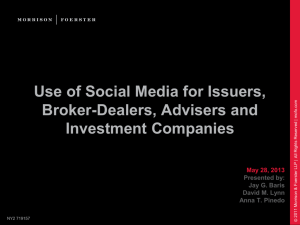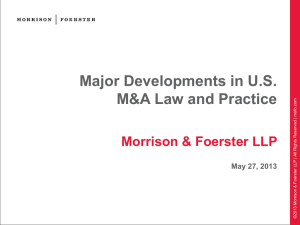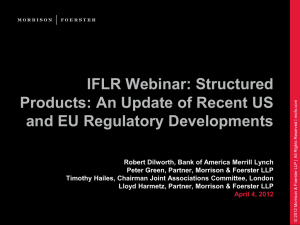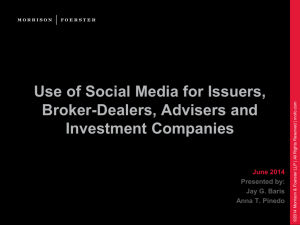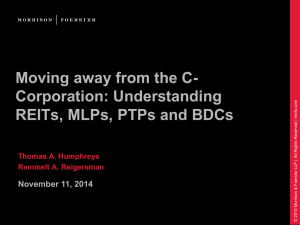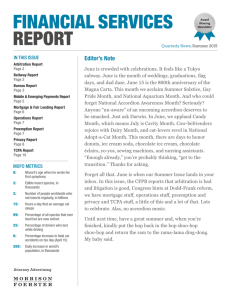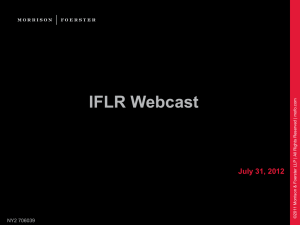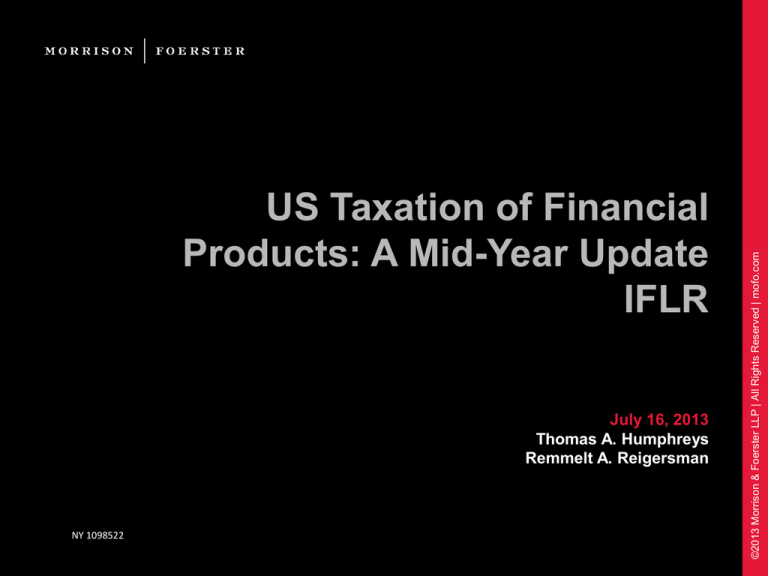
July 16, 2013
Thomas A. Humphreys
Remmelt A. Reigersman
NY 1098522
©2013 Morrison & Foerster LLP | All Rights Reserved | mofo.com
US Taxation of Financial
Products: A Mid-Year Update
IFLR
Agenda
• Introduction
• Ambac—Tax Treatment of Credit Default Swaps
• Notice 2013-48 – Wash Sales/Money Market Fund Shares
• FATCA Update
• Debt vs. Equity
Trust Preferred Securities
Contingent Convertible Bonds
Caselaw Developments
U.S. View
• Excess Mortgage Servicing REIT
• Basket Option Contracts
• Tax Reform?
• Structured Notes
This is MoFo.
2
Current U.S. Tax Rates
Marginal Rates
For Married Individuals Filing Jointly
with Taxable Income
Over $450,000
39.60%
Maximum Dividend and Capital Gain Rates
For Unmarried Individuals with
For Married Individuals Filing Jointly
Taxable Income
with Taxable Income
Up to $400,000
Up to $450,000
Over $400,000
Over $450,000
15%
20%
Medicare Tax on Net Investment Income
For Unmarried Individuals with
For Married Individuals Filing Jointly
Modified Adjusted Gross Income
with Modified Adjusted Gross Income
Over $200,000
Over $250,000
3.8%
For Unmarried Individuals with
Taxable Income
Over $400,000
Interest
Dividends
This is MoFo.
Maximum Combined Tax Rates on Interest and Dividends
39.60% + 3.80% = 43.40%
20% + 3.80% = 23.80%
3
Ambac CDS
AMBAC’s subsidiary (AMBAC Assurance Corporation) was in the
financial guarantee insurance business
AAC wrote credit default swaps (“CDS”) on asset/mortgage backed
securities, many of which were rated “AAA”
AAC received periodic payments from third parties and agreed to
pay the loss, if any, upon a default
When the financial crisis hit, the AMBAC consolidated group claimed
over $4 billion in ordinary losses relating to its CDS and carried the
loss back for a $700 million IRS tax refund
AMBAC’s parent filed for federal bankruptcy protection in November,
2010, largely because of fear the IRS would try to clawback the
refund
This is MoFo.
4
Ambac CDS
Tax issue: Whether losses on CDS were capital or ordinary and
whether they were currently deductible (AMBAC’s position) or
deductible only when paid (IRS position)?
IRS Notice 2004-52: IRS seeks “further information” on CDS
Prop. Reg. section 1.446-3(c)(1)(iii) [September 16, 2011]: CDS are
notional principal contracts entitled to ordinary income and loss
treatment
This is MoFo.
5
Settlement (Announced April 9, 2013)
• AMBAC will pay the Government $101.9 million.
• AMBAC liable for possible future additional payments of up to $14.9
million.
• AMBAC will reduce its net operating loss carryovers attributable to
the CDS contracts at issue by $1 billion.
• Manhattan U.S. Attorney Preet Bharara: “The proposed settlement
reflects an extensive investigation into Ambac’s reported financial
losses and accounting methods in the wake of the financial crisis,
and, if approved, will result in a significant recovery of Treasury
funds. The settlement will also prevent Ambac from taking $1 billion
in future offsets against its income and thus potentially reducing its
tax burden by several hundred million dollars, a reduction to which it
is not entitled.”
This is MoFo.
6
Notice 2013-48—Wash Sales/Money Market Fund Shares
• Issue: SEC proposal that certain money market funds will not
maintain a $1 per share net asset value
• This raises the prospect that a shareholder could redeem shares at a
loss, then reinvest within the 30 day wash sale period and have the
loss deferred under IRC § 1091
• Notice 2013-48: 0.5% de minimis standard where IRS will not
disallow loss under wash sale rules
This is MoFo.
7
FATCA Update
Foreign Account Tax Compliance Act (2010)—Designed to Find
“Undisclosed” Foreign Bank Accounts Held by U.S. Taxpayers
New IRC Section 1471: A Withholding Agent Must Withhold 30% on All
“Withholdable Payments” Made to a Foreign Financial Institution
Unless the FFI Signs an Agreement with the IRS to Information Report
on its U.S. Account Holders
A “Withholdable Payment” is:
Any U.S.-source payment of interest, dividends and other fixed or determinable
annual or periodical gains, profits, and income (“FDAP”); for example bond
interest or stock dividends
Gross proceeds from sale of property that is of a type that can produce U.S.source dividends or interest, for example gross proceeds on the sale of stocks or
bonds
This is MoFo.
8
FATCA: Key Dates
FATCA Withholding Dates
Withholdable Payments:
Withholding begins on:
Any payment of U.S. source FDAP income, such
as U.S. source interest (including OID) and
dividends
July 1, 2014
Gross proceeds from the disposition of property
producing FDAP-type income
January 1, 2017
Foreign passthru payments
January 1, 2017
Grandfathered Obligations:
Obligation must be outstanding on:
All Obligations
July 1, 2014
This is MoFo.
9
Debt vs. Equity is Still With Us…
• Trust Preferred Securities
• Contingent Convertible Bonds
• Caselaw Developments
• U.S. View
This is MoFo.
10
Trust Preferred Securities
• Trust preferred securities are in the process of being phased out as
Tier 1 regulatory capital as a result of Dodd-Frank and Basel III.
• As a result, most trust preferreds are being called or refinanced.
The refinancing, however, has occurred at a much slower pace.
In 2012, $46.6 billion of trust preferreds were called, but only $21.3 billion of new
preferred stock was issued.
This is MoFo.
11
Contingent Convertible Bonds
• Barclays Bank PLC as issuer.
$3 billion CoCo (November 2012).
• 7.625% ten year notes, holder must transfer for “nil” value to parent if
Barclays’ CET1 declines below 7%.
$1 billion CoCo (April 2013).
• 7.75% ten year notes (callable after five years), holder must transfer for “nil”
value to parent if Barclays’ CET1 declines below 7%.
• Tax issues – debt or equity?
Unconditional promise to pay a sum certain?
• Treatment in the UK—tax deductible under current law.
• Treatment of U.S. holders—equity eligible for preferential “qualified
dividend income” treatment.
This is MoFo.
12
Caselaw Developments
• Recent debt v. equity caselaw
PepsiCo Puerto Rico (TC Memo 2012-269). Held: Equity – taxpayer wins.
NAGP (ScottishPower) (TC Memo 2012-172). Held: Debt – taxpayer wins.
Hewlett-Packard (TC Memo 2012-135). Held: Debt – taxpayer loses.
• 11-13 factors
Citing Hardman v. United States, 827 F.2d 1409 (9th Cir. 1987) (11 factors);
Estate of Mixon v. United States, 464 F.2d 394 (5th Cir. 1972) (13 factors); A.R.
Lantz Co. v. United States, 424 F.2d 1330 (9th Cir. 1970) (11 factors); Dixie
Dairies Corp. v. Commissioner, 74 T.C. 476 (1980) (13 factors), etc.
• Find out what the law is in your Circuit!
This is MoFo.
13
U.S. View
• Orderly Liquidation Authority—Dodd Frank grants extraordinary
powers to FDIC.
• Financial institution creditors subject to “bail-in” of their debt.
• So in the U.S., rather than replace trust preferred with a new tax
deductible instrument (like CoCos), the plan is to make debt more
equity-like.
This is MoFo.
14
Excess Mortgage Servicing REIT
• Mortgage Servicing Fee = reasonable fee + “Excess Servicing Spread”
• Excess Servicing Spread treated as a coupon strip under Section 1286.
• REIT Requirements:
At least 75% of a REIT’s assets must be “real estate assets”
At least 75% of a REIT’s gross income must be “qualifying income.”
Includes interest on obligations secured by mortgages on real
property or interests in real property
This is MoFo.
15
Excess Mortgage Servicing REIT
• Questions:
Is the Excess Servicing Spread a “real estate asset”?
Is income from the Excess Servicing Spread “qualifying income”?
• PLRs 201234006 & 201328018: Yes. Excess servicing spread is a real
estate asset and generates qualifying REIT income.
This is MoFo.
16
Basket Option Contracts
• Bank buys portfolio of stocks desired by Fund
• Fund buys a two-year option whose value is tied to the portfolio.
• Fund controls the contents of the portfolio.
• Despite constant turnover in portfolio, Fund continues to hold only one
asset, the option.
This is MoFo.
17
Basket Option Contracts
• Desired result: Long-term capital gain rather than short-term trading gain
• IRS Memorandum AM 2010-005:
Fund owns the portfolio, must recognize gain and loss from trades in
the portfolio
“Particularly aggressive” transaction
• Bloomberg article: “Simons Strategy to Shield Profit From
Taxes Draws IRS Ire,” July 1, 2013
This is MoFo.
18
Tax Reform?
• Current System for Taxing Derivatives
• House Ways & Means Committee Discussion Draft
Mark-to-Market for Derivatives
Accrual of Market Discount
COD on Debt Exchanges
Average Basis
Hearings Held on March 20, 2013
This is MoFo.
19
Current System for Taxing Derivatives
• Current tax treatment of certain financial instruments traded on the
various exchanges:
Instrument Categorization for Federal
Income Tax Purposes
Options
"1256 Contracts“
(e.g. S&P 500 options)
Governing
Tax Treatment
Provision / Law
IRC Section
1256
60% long-term capital gain/loss;
40% short-term capital gain/loss
Non-”1256 Contracts”(e.g. options "Openon a narrow-based stock index)
Transaction"
Wait-and-see approach;
Capital gain/loss
Futures
"1256 Contracts“
(e.g. Oil Futures)
60% long-term capital gain/loss;
40% short-term capital gain/loss
Securities
Futures
Securities futures (e.g. futures on IRC Section
Google stock on OneChicago)
1234B
Wait-and-see approach;
Capital gain/loss
Swaps
Carved out from Section 1256 by Regulations
Dodd-Frank (e.g. Oil Swaps)
1.446-3
Current accrual;
Capital gain/loss;
Contingent payments?
This is MoFo.
IRC Section
1256
20
Mark-to-Market for Derivatives
• Academics have been calling for a mark-to-market system for the
taxation of financial instruments for a long time.
• Joint Senate Finance – House Ways & Means Committee hearing on
December 6, 2011.
• JCT Report identifies the five financial instruments:
Stock
Debt
Options
Forwards
Notional Principal Contracts
This is MoFo.
21
Mark-to-Market for Derivatives
• Chairman Dave Camp (R-MI) of the House Ways & Means
Committee proposed a mark-to-market system for the taxation of
“derivatives” on January 24, 2013.
• Press Release:
“The lack of consistent and comprehensive tax policy has also contributed to
some corporate scandals and the recent financial crisis that devastated our
economy and threatened our standing in the global community. Updating these
tax rules to reflect modern developments in financial products will make the code
simpler, fairer and more transparent for taxpayers; and it will also help to minimize
the potential for abuse that has occurred in the past.”
• Subcommittee Hearing: March 20, 2013
This is MoFo.
22
Mark-to-Market for Derivatives
• New Code Sections
IRC Section 485 – Treatment of “derivatives”.
IRC Section 486 – “Derivatives” defined.
• Applies to all derivatives held by dealers (who are currently subject to
IRC Section 475 with respect to derivatives held as inventory or for
sale).
This is MoFo.
23
Mark-to-Market for Derivatives
• Obsolete Code Sections
IRC Section 1234B – Gain or loss on a securities futures contract treated as gain
or loss from the sale or exchange of property that has the same character as the
underlying property in the hands of the taxpayer.
IRC Section 1236 – Capital gains treatment for securities that are held by dealers
for personal investment.
IRC Section 1256 – 60/40 treatment (60% long-term capital gain and 40% shortterm capital gain) for certain futures and options contracts.
This is MoFo.
24
Mark-to-Market for Derivatives
• Basic Rule
Mark-to-market – any derivative held at the close of a taxable year is treated as
sold for its fair market value on the last business day of such year, and gain or
loss would be recognized in such year.
Basis – ongoing adjustments for gain or loss recognized.
Items of Income, Gain, Loss, and Deduction
• Treated as ordinary income or loss.
• Treated as attributable to a trade or business for purposes of IRC Section
172(d)(4), which limits the non-trade or business deductions of non-corporate
taxpayers to non-trade or business income.
This is MoFo.
25
Mark-to-Market for Derivatives
• “Derivative” definition would be broad:
Any evidence of an interest in (or any derivative financial instrument with respect
to) stock, partnership interest, beneficial ownership interest in a trust, debt, real
property (with certain exceptions), actively traded commodity, currency, and
notional principal contract.
Includes any “derivative financial instrument” with respect to any of the above.
• Derivative Financial Instrument: any option, forward contract, futures contract,
short position, swap, or similar financial instrument.
Includes any “embedded derivative component” in a debt instrument.
• Embedded Derivative Component: any term of a debt instrument that affects
its cash flow or the value of other payments required by the instrument in a
way similar to a derivative.
Does not include stock, straight debt, CPDI or VRDI.
As written would include compensatory options and options on partnership
interests.
This is MoFo.
26
Mark-to-Market for Derivatives
• Special Provisions
Mixed Straddles – mark-to-market regime applies to all non-derivative positions
that are part of a tax straddle with a derivative.
Terminations / Transfers – mark-to-market regime applies to any termination or
transfer of the rights or obligations with respect to a derivative during the taxable
year, whether by exercise, settlement, etc.
Fair Market Value
• If not readily ascertainable, look to method used in report or statement (i) to
shareholders, partners or other persons provided in the applicable Treasury
Regulations, or (ii) for credit purposes.
• Fair market value of an “embedded derivative component” in a instrument is
(i) the fair market value of the instrument with the component over (ii) the fair
market value of the instrument without the component.
This is MoFo.
27
Mark-to-Market for Derivatives
• Unanswered Questions
Who will be covered?
• Existing derivatives - grandfathered?
• Opportunity to opt-in to the regime?
What will be covered?
• Mutual funds?
Coordination with IRC Section 1032
• IRC Section 1032: “. . . No gain or loss shall be recognized by a corporation
with respect to any lapse or acquisition of an option . . . to buy or sell its stock
(including treasury stock).”
This is MoFo.
28
Structured Notes
• 2012 volume of structured products and structured notes
SEC registered offerings of structured products amounted to $65 billion in gross
sales.
U.S. is now the third largest market of structured products globally, just behind
Italy and Germany.
548 notes linked to Apple Inc. sold in the U.S., totaling $1.74 billion.
57% decline in sales of U.S. reverse convertibles.
This is MoFo.
29
Structured Notes
• Tax Treatment
“Bifurcation” of debt instruments for tax purposes abandoned in 1994.
Current accrual for contingent debt instruments, but not for other contingent
financial instruments.
Non-debt instruments are subject to the “open-transaction” doctrine – essentially a
“wait and see” approach.
• SEC Disclosure Requirements
SEC now requires issuers to disclose the “issuer estimated value” of structured
notes on the cover page of the offering document.
The estimated value is to be based on the value of the bond element and the
derivative element of the structured note separately.
This is MoFo.
30
Structured Notes
• SEC Disclosure Requirements (continued)
Sample disclosure:
“The estimated value of your notes at the time the terms of your notes were set on
the trade date (as determined by reference to pricing models used by [issuer] and
taking into account our credit spreads) was equal to approximately $974 per
$1,000 face amount, which is less than the original issue price. The value of your
notes at any time will reflect many factors and cannot be predicted; however, the
price (not including [issuer]’s customary bid and ask spreads) at which [issuer]
would initially buy or sell notes (if it makes a market, which it is not obligated to do)
and the value that [issuer] will initially use for account statements and otherwise
equals approximately $990 per $1,000 face amount, which exceeds the estimated
value of your notes as determined by reference to these models.”
This is MoFo.
31
Circular 230
To ensure compliance with requirements imposed by
the IRS, Morrison & Foerster LLP informs you that, if
any advice concerning one or more U.S. Federal tax
issues is contained in this communication (including
any attachments), such advice is not intended or
written to be used, and cannot be used, for the purpose
of (i) avoiding penalties under the Internal Revenue
Code or (ii) promoting, marketing or recommending to
another party any transaction or matter addressed
herein.
This is MoFo.
32




